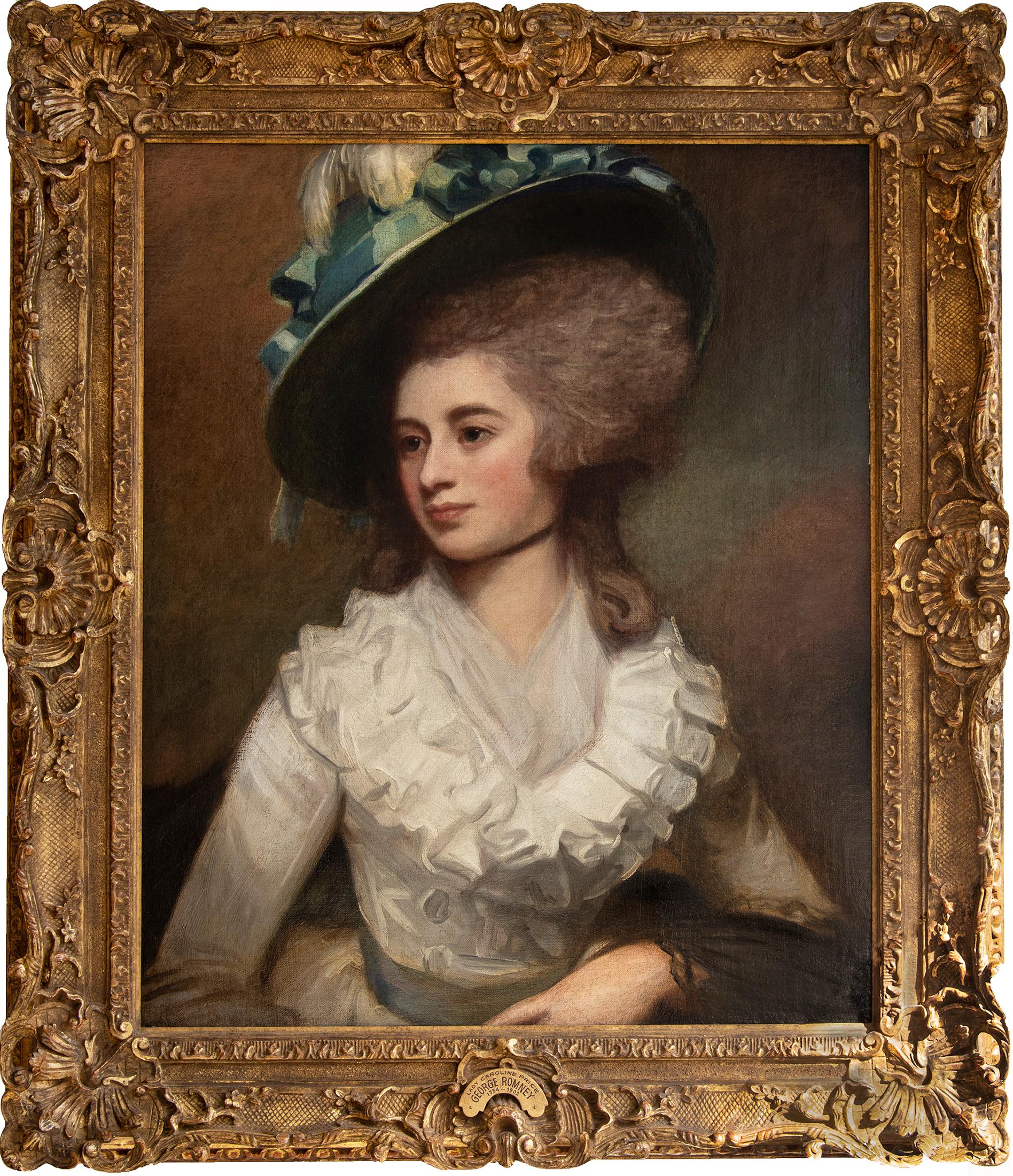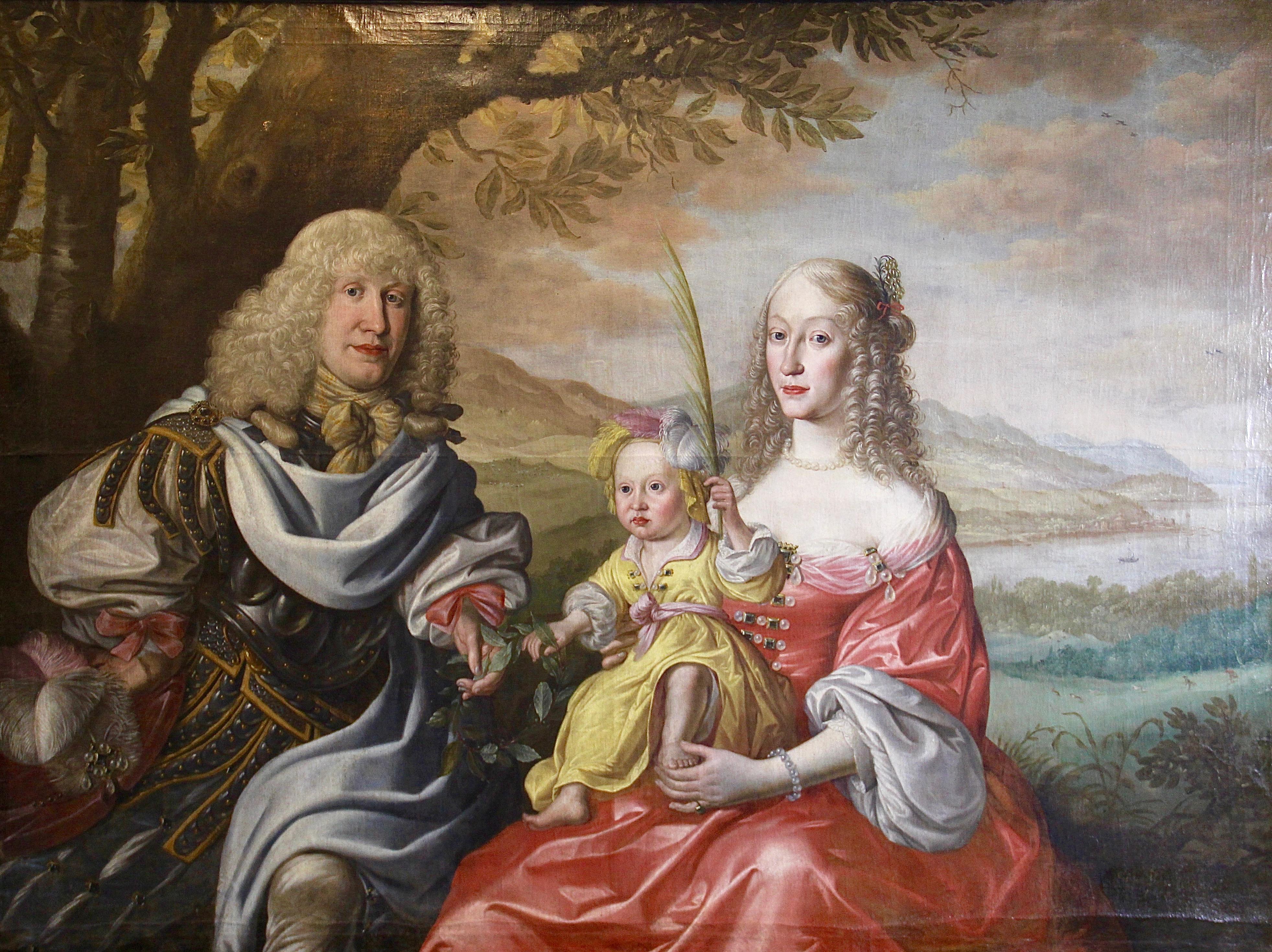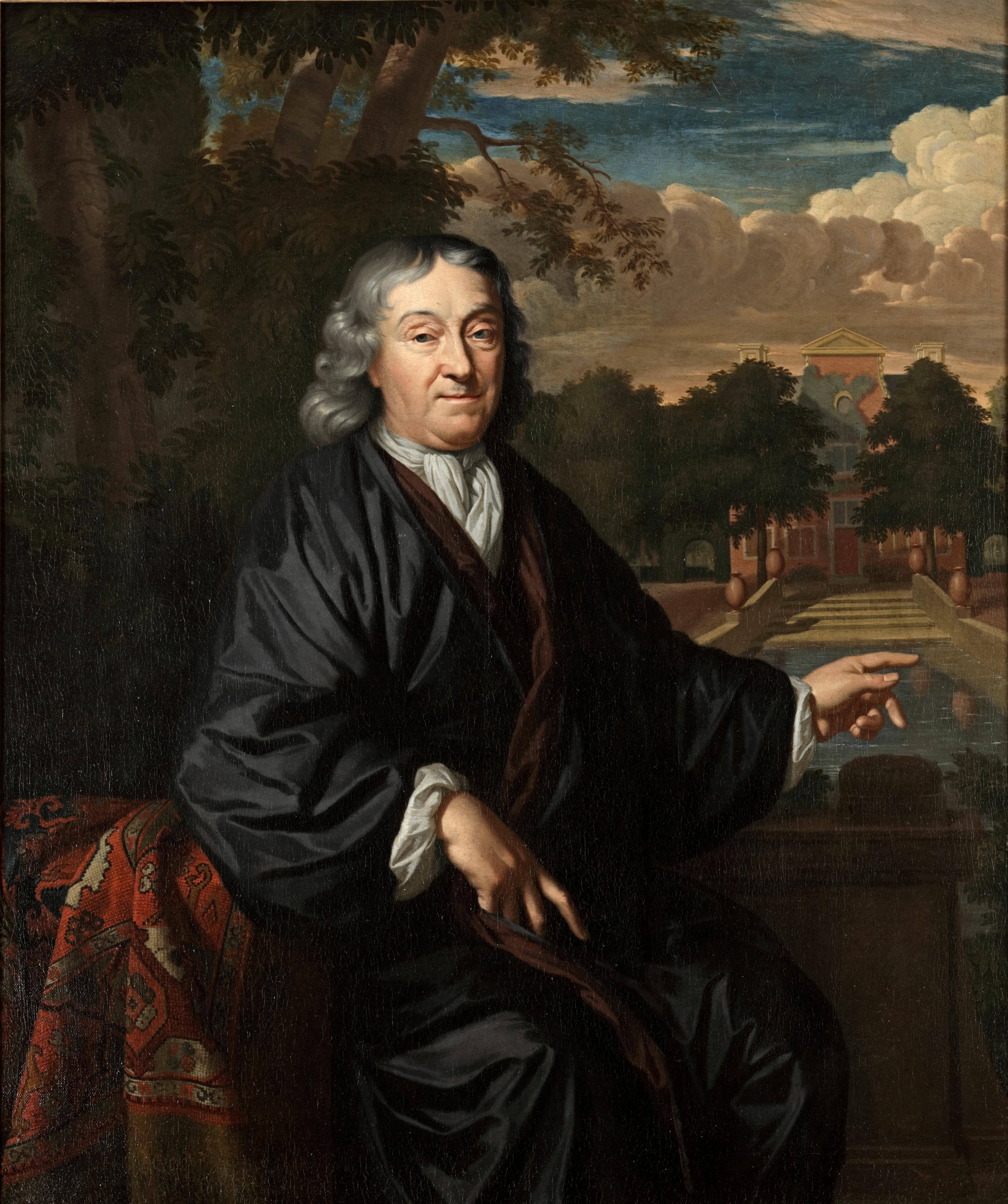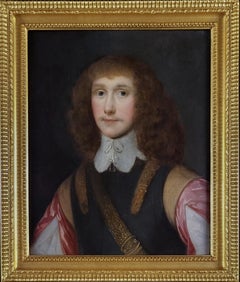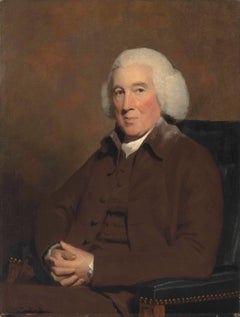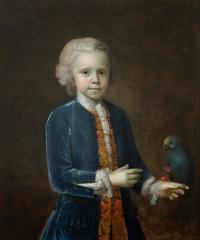
Portrait of a Boy with Parrot
View Similar Items
Want more images or videos?
Request additional images or videos from the seller
1 of 6
Richard Van BleeckPortrait of a Boy with Parrot1732
1732
About the Item
- Creator:Richard Van Bleeck (1670 - 1733, Dutch)
- Creation Year:1732
- Dimensions:Height: 33.67 in (85.5 cm)Width: 28.94 in (73.5 cm)
- Medium:
- Movement & Style:
- Period:
- Condition:
- Gallery Location:Bath, GB
- Reference Number:Seller: 931stDibs: LU952904303
About the Seller
5.0
Vetted Seller
These experienced sellers undergo a comprehensive evaluation by our team of in-house experts.
Established in 2002
1stDibs seller since 2015
36 sales on 1stDibs
Typical response time: 1 hour
Associations
The British Antique Dealers' AssociationLAPADA - The Association of Arts & Antiques DealersInternational Confederation of Art and Antique Dealers' Associations
More From This SellerView All
- 17th century portrait of a ladyBy Nicolaes MaesLocated in Bath, SomersetPortrait of a lady by Dutch Golden Age painter Nicolaes Maes (1634-1693). Half-length, within a feigned oval, the lady wears a pearl necklace and earrings, an ivory silk gown adorned...Category
17th Century Old Masters Portrait Paintings
MaterialsCanvas, Oil
- English 18th century portrait of a Lady and her Daughter in an interiorBy (attributed to) Joseph HighmoreLocated in Bath, SomersetPortrait of a lady, three-quarter length, wearing a blue silk gown, seated in a classical interior, with her daughter in a pink gown standing beside her holding a sprig of blossom. T...Category
Early 18th Century Old Masters Portrait Paintings
MaterialsOil
- English 17th century portrait of James Thynne as a young boy by a fountainBy Johann KerseboomLocated in Bath, SomersetPortrait of the Hon. James Thynne (c. 1680-1704), full-length, in the gardens of Longleat House, seated beside a fountain, holding a shell beneath water spouting from a horn blown by a cherub on a dolphin. A glimpse of part of Longleat House can be seen upper left. Oil on canvas in a period giltwood frame, decorated with leaves and acorns. C. 1682. Dimensions: 145 x 123cm (57 x 48in) in frame Provenance: Ex Longleat House, Wiltshire Private collection, Bath James Thynne was the youngest son of Thomas Thynne, 1st Viscount Weymouth and Frances Finch of Longleat House, Wiltshire. He died in his youth and his Aunt, Anne Kingsmill Finch, Countess of Winchilsea (1661-1720), wrote a moving poem on his death. He was buried in the family vault at Longbridge Deverill, Wiltshire. A mezzotint of this painting by William Faithorne the Younger is held in the Royal Collection. Johann Kerseboom (d.1708) was the nephew of Frederick Kerseboom and first worked in Germany before coming to England in the 1680's where his sitters included the 'Electress Sophia Dorothea' (known from a mezzotint by William Faithorne). His early works were influenced by William Wissing...Category
17th Century Old Masters Portrait Paintings
MaterialsOil, Canvas
$25,030 Sale Price20% Off - Attributed to John Riley, 17th century English portrait of a girl on a terraceBy John RileyLocated in Bath, SomersetPortrait of a young girl, full-length, wearing a blue silk gown, standing on a terrace beside a classical urn holding a branch with blossom. Attributed to John Riley...Category
17th Century Old Masters Portrait Paintings
MaterialsOil, Canvas
$26,073 Sale Price25% Off - 17th century Dutch portrait of a Lady in Red adorned with PearlsBy Pieter NasonLocated in Bath, SomersetPortrait of a lady, half-length in a feigned oval wearing a ruby coloured silk gown holding entwined strings of pearls across her bodice. Signed 'PNason' and dated 1667 (lower right)...Category
17th Century Old Masters Portrait Paintings
MaterialsOil, Canvas
$25,030 Sale Price20% Off - A portrait of a lady and her daughter with an exotic birdBy Michael DahlLocated in Bath, SomersetA portrait of a lady three-quarter length, seated in an interior, wearing a red silk gown draped in a pink silk sash with an exotic bird perched on her hand and one arm resting on a stone plinth, her young daughter wearing a green silk gown standing at her side. Oil on canvas, housed in a period 'Lely' giltwood frame. This double portrait was painted at the height of Dahl's career in circa 1715 when Dahl had become firmly established as one of the leading portrait painters in Britain. Although the identities of the sitters are currently unknown, it is a sensitive depiction of a close and affectionate bond between a mother and daughter, with the young girl's hand resting affectionately on her mothers lap. The tamed exotic bird adds a charming decorative element which also serves to convey the high social status of the lady, given only the very wealthy would be able to own such a rare and expensive pet and the lively colouring of the bird's feathers is reflected in the colours of the sitters' silk gowns. Provenance: Private collection, London Michael Dahl (Stockholm 1659-1743 London) was born in Stockholm in Sweden and studied under Martin Hannibal (d 1741) and later with David Klöcker Ehrenstrahl. In 1682 he travelled to London, where he became acquainted with Godfrey Kneller and Henry Tilson, and in 1685 he left for Europe with Tilson, working briefly in Paris before continuing to Venice and Rome, where they stayed for about two years. In Rome Dahl converted to Roman Catholicism and gravitated towards the circle of Christina, former Queen of Sweden, who sat for him (Grimsthorpe Castle, Lincs). He returned to England with Tilson via Frankfurt and arrived in London in 1689, staying in England for the remainder of his career. During Dahl's absence, Kneller had consolidated his supremacy in London as the most fashionable portrait painter, but Dahl rapidly became Kneller’s closest competitor. His patrons probably had roots in the Swedish diplomatic circles, but it expanded as a result of his ability and his agreeable personality. His prices were lower than those of Kneller and he favoured softer, more diffused, colour tones and could respond to his sitters with sincerity and humanity. Politically, Kneller supported the ascendant Whigs while Dahl was a Tory, but they frequently painted the same sitters from both parties, and in spite of fundamental differences in technique and temperament, their work was sometimes similar in appearance. Dahl was prolific but rarely signed his work, and comparatively few of his portraits were engraved in mezzotint, the method used by Kneller to widen his reputation. By 1690 he had painted the aged Duke of Schomberg (engraved by William Faithorne) and Prince George of Denmark (London, Kensington Palace). He was ignored by William III but received commissions from Princess Anne, including one for a portrait of herself (Oakly Park, Ludlow, Salop). He also painted the future Duke and Duchess of Marlborough, and his informal portrait of the Duchess (Althorp House, Northants), formerly attributed to Kneller, is perhaps the most intimate of all images of her. During the 1690s he secured the patronage of Charles Seymour, the ‘Proud’ 6th Duke of Somerset, who ordered a series of seven full-length portraits of notable contemporary beauties from Dahl (1690s; Petworth House, W. Sussex, NT). This was originally a scheme similar to Kneller’s more famous ‘Hampton Court Beauties’, but the portraits were subsequently reduced to three-quarter-length formats. The features of the sitters are not individualized, but they possess a decorative, languorous glamour that recalls Lely rather than Kneller. Somerset gave Dahl further employment over the next 25 years. In 1698, following the death of Klöcker Ehrenstrahl, Dahl was offered the post of court painter at Stockholm, which he apparently refused, preferring to remain in London at his studio in Leicester Fields, near the Swedish legation. In about 1700 he was joined by a young compatriot, Hans Hysing, who worked with him for many years. Dahl seems not to have married until after 1708, He had a son Michael (d. 1741), also a painter, of whose work nothing is known, and two daughters. After the accession of Queen Anne in 1701, she and Prince George sat for a number of official portraits. His royal patronage ceased with Queen Anne’s death, and when Dahl refused to paint the infant Duke of Cumberland in 1722. He was suspected of Jacobite sympathies, and relations had cooled between him and the Swedish legation. However, his practice continued to prosper, and he acquired another important patron in Edward Harley, 2nd Earl of Oxford, who shared his political views and whose circle included the architect James Gibbs and the poets Matthew Prior and Alexander Pope, all of whom Dahl painted. Oxford commissioned several portraits of himself. In the earliest (1719; Welbeck Abbey...Category
Early 18th Century Old Masters Portrait Paintings
MaterialsCanvas, Oil
You May Also LikeView All
- Portrait of Gentleman, Thomas Bruce, Earl of Elgin c.1638 Manor House ProvenanceLocated in London, GBTitan Fine Art present this picture which formed part of a historic collection of an English aristocratic family, Lord and Lady Sandys at their magnificent baroque and Regency Grade-...Category
17th Century Old Masters Portrait Paintings
MaterialsOil, Wood Panel
- Portrait of a Lady Diana Cecil, Countess of Elgin c.1638, Manor House ProvenanceLocated in London, GBTitan Fine Art present this picture which formed part of a historic collection of an English aristocratic family, Lord and Lady Sandys at their magnificent baroque and Regency Grade-...Category
17th Century Old Masters Portrait Paintings
MaterialsOil, Wood Panel
- 18th Century Oil Painting Portrait of Provost John Pitcairn of DundeeBy Sir Henry RaeburnLocated in London, GBThe pendant to the present portrait showing John Pitcairn's wife Jean, née Robertson, is in the Huntington Art Gallery, San Marino. Both works are datable to the 1790s. Pitcairn, who served as Provost of Dundee from 1782-84, a position his father-in-law also held from 1731-32, later sat to Raeburn for another portrait, dated to circa 1820, which is now in the Royal Scottish Academy, Edinburgh Sale of Christie's London: Wednesday, July 9, 2014 [Lot 00212] Old Master & British Paintings Day Sale Sold For 22,500 GBP Premium Provenance By descent from the sitter to his great-grandson, Ronald Andrew Pitcairn of Pitcullo; Christie's, London, 25 June 1904, lot 58 (200 gns. to Wallis). Alexander Reid, Glasgow. With Agnew's, London, where acquired by A.R. Wilson Wood, 7 April 1909; Christie's, London, 26 June 1914, lot 78 (850 gns. to Agnew). Anonymous sale; Christie's, London, 24 November 1972, lot 27 (320 gns.) Private collection, Dublin, Ireland Exhibition Edinburgh, Royal Scottish Academy, 1876, no. 256 Literature W. Armstrong, Sir Henry Raeburn, London, 1901, p. 110. J. Greig, Sir Henry Raeburn, R.A., His life and work with a catalogue of his pictures, London, 1911, p. 55. R. Asleson and S.M. Bennett, British Paintings at The Huntington, New Haven and London, 2001, p. 312, fig. 12 Sir Henry Raeburn FRSE RA RSA (4 March 1756 – 8 July 1823) was a Scottish portrait painter and Scotland's first significant portrait painter since the Union to remain based in Scotland. He served as Portrait Painter to King George IV in Scotland. Raeburn was born the son of a manufacturer in Stockbridge, on the Water of Leith: a former village now within the city of Edinburgh. He had an older brother, born in 1744, called William Raeburn. His ancestors were believed to have been soldiers, and may have taken the name "Raeburn" from a hill farm in Annandale, held by Sir Walter Scott's family. Orphaned, he was supported by William and placed in Heriot's Hospital, where he received an education. At the age of fifteen he was apprenticed to the goldsmith James Gilliland of Edinburgh, and various pieces of jewellery, mourning rings and the like, adorned with minute drawings on ivory by his hand, still exist. Soon he took to the production of carefully finished portrait miniatures; meeting with success and patronage, he extended his practice to oil painting, at which he was self-taught. Gilliland watched the progress of his pupil with interest, and introduced him to David Martin, who had been the favourite assistant of Allan Ramsay the Latter, and was now the leading portrait painter in Edinburgh. Raeburn was especially aided by the loan of portraits to copy. Soon he had gained sufficient skill to make him decide to devote himself exclusively to painting. George Chalmers (1776; Dunfermline Town Hall) is his earliest known portrait. In his early twenties, Raeburn was asked to paint the portrait of a young lady he had noticed when he was sketching from nature in the fields. Ann was the daughter of Peter Edgar of Bridgelands, and widow of Count James Leslie of Deanhaugh. Fascinated by the handsome and intellectual young artist, she became his wife within a month, bringing him an ample fortune. The acquisition of wealth did not affect his enthusiasm or his industry, but spurred him on to acquire a thorough knowledge of his craft. It was usual for artists to visit Italy, and Raeburn set off with his wife. In London he was kindly received by Sir Joshua Reynolds, the president of the Royal Academy, who advised him on what to study in Rome, especially recommending the works of Michelangelo, and gave Raeburn letters of introduction for Italy. In Rome he met his fellow Scot Gavin Hamilton, Pompeo Girolamo Batoni and Byers, an antique dealer whose advice proved particularly useful, especially the recommendation that "he should never copy an object from memory, but, from the principal figure to the minutest accessory, have it placed before him." After two years of study in Italy he returned to Edinburgh in 1787, and began a successful career as a portrait painter. In that year he executed a seated portrait of the second Lord President Dundas. Examples of his earlier portraiture include a bust of Mrs Johnstone of Baldovie and a three-quarter-length of Dr James Hutton...Category
18th Century Old Masters Figurative Paintings
MaterialsOil
- 18th century portrait of the painter Nathaniel DanceLocated in London, GBCollections: Robert Gallon (1845-1925); Private Collection, UK. Oil on canvas laid down on panel Framed dimensions: 11.5 x 10 inches This highly engaging, previously unpublished portrait by Johan...Category
18th Century Old Masters Portrait Paintings
MaterialsOil, Wood Panel, Canvas
- Head of an AngelLocated in New York, NYProcaccini was born in Bologna, but his family moved to Milan when the artist was eleven years old. His artistic education was evidently familial— from his father Ercole and his elder brothers Camillo and Carlo Antonio, all painters—but his career began as a sculptor, and at an early age: his first known commission, a sculpted saint for the Duomo of Milan, came when he was only seventeen years old. Procaccini’s earliest documented painting, the Pietà for the Church of Santa Maria presso San Celso in Milan, was completed by 1604. By this time the artist had made the trip to Parma recorded by his biographers, where he studied Correggio, Mazzola Bedoli, and especially Parmigianino; reflections of their work are apparent throughout Procaccini's career. As Dr. Hugh Brigstocke has recently indicated, the present oil sketch is preparatory for the figure of the angel seen between the heads of the Virgin and St. Charles Borrommeo in Procaccini's altarpiece in the Church of Santa Afra in Brescia (ill. in Il Seicento Lombardo; Catalogo dei dipinti e delle sculture, exh. cat. Milan 1973, no. 98, pl. 113). As such it is the only known oil sketch of Procaccini's that can be directly connected with an extant altarpiece. The finished canvas, The Virgin and Child with Saints Charles Borrommeo and Latino with Angels, remains in the church for which it was painted; it is one of the most significant works of Procaccini's maturity and is generally dated after the artist's trip to Genoa in 1618. The Head of an Angel is an immediate study, no doubt taken from life, but one stylistically suffused with strong echoes of Correggio and Leonardo. Luigi Lanzi, writing of the completed altarpiece in 1796, specifically commented on Procaccini's indebtedness to Correggio (as well as the expressions of the angels) here: “Di Giulio Cesare...Category
17th Century Old Masters Figurative Paintings
MaterialsPaper, Canvas, Oil
- 19th century portrait painted in St Petersburg in 1819Located in London, GBSigned, inscribed and dated, lower right: 'Geo Dawe RA St Petersburgh 1819', also signed with initials, lower centre: 'G D RA'; and signed and inscribed verso: 'Geo Dawe RA Pinxit 1819 St Petersburgh'; Also inscribed on the stretcher by Cornelius Varley with varnishing instructions. Collections: Private collection, UK, 2010 Literature: Galina Andreeva Geniuses of War, Weal and Beauty: George Dawe...Category
19th Century Old Masters Portrait Paintings
MaterialsOil, Canvas
Recently Viewed
View AllMore Ways To Browse
Still Life Painting 18th C
Cox Of London
18th Century Waistcoat
James Cox
Parrot Painting Still Life Oil
Richard Ellis
Oil Painting Still Life With Parrot
Cox And Sons
Lady With Parrot
Lady With A Parrot
Embroidered Waistcoat
Parrot 18th Oil
James Drummond
Lac Leman
Leighton Jones
Madame Brun
Oliver Samsinger
Order Eastern Star








